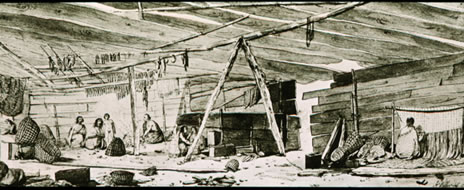
Lesson Five:
Natives and the Maritime Fur Trade
A Native cedar plank home on Nootka Sound, 1770s.
From James Cook, A Voyage of Discovery to the North Pacific Ocean. London, 1801. Sketch by John Webber. (University of Washington Special Collections.)
The maritime fur trade, although often overlooked in textbooks, was a crucial phase in the early history of the Pacific Northwest. For one thing, the opportunity to make money attracted non-Indian peoples to the region much more quickly than they otherwise might have come, so that dozens of ships sailed to the Northwest Coast within two decades of the first explorers' arrival. It is unlikely, for example, that British interest in the region would have been so keen had not Cook's crew discovered the profitability of sea otter pelts in Chinese markets. Moreover, early maritime fur traders behaved as explorers because, in seeking more furs (or, more correctly, Indians willing to sell furs more cheaply), they scouted a great deal of the coastline in the region, filling in the many gaps that "real" explorers like Cook and Vancouver had left in their maps. But the most important aspect of the maritime fur trade was that it brought natives and non-natives into immediate and close contact, with profound ramifications for both peoples and for regional history.
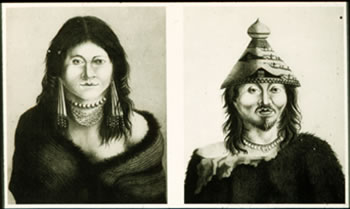 Tatoosh and Wife, Neah Bay, 1792 (right).These engravings after early drawings show some of the bold patterning of Northwest Coast native art.
Neah Bay is now the site of the Makah reservation. From Alejandro Malaspina, Vaije Politico-Clientifico Albredor del Mundo. Madrid, 1885. Sketch by Jose Cardero. (University of Washington Special Collections)
Tatoosh and Wife, Neah Bay, 1792 (right).These engravings after early drawings show some of the bold patterning of Northwest Coast native art.
Neah Bay is now the site of the Makah reservation. From Alejandro Malaspina, Vaije Politico-Clientifico Albredor del Mundo. Madrid, 1885. Sketch by Jose Cardero. (University of Washington Special Collections)
It is important to keep in mind that direct contact with non-natives was not the only source of change among Indian peoples. Carlos Schwantes's depiction of the "first" Pacific Northwesterners (28-38) is valuable for understanding the three different, broad cultural groupings of natives in the region, but one should not take away from that description the sense that native societies were static or unchanging until white explorers arrived. Before Europeans migrated to North America, native societies underwent modification as their cultures evolved, as climates changed, and as contact with one another introduced new cultural elements. Once Europeans began colonizing North America after 1492, native societies were affected by a more accelerated pace of change. Even tribes in the Pacific Northwest, quite isolated from sites of European colonization elsewhere, were affected by that colonization. Before Europeans arrived on the Northwest Coast in 1774, the diseases and livestock they had imported elsewhere to North America had already reached local Indian groups (traveling between native peoples rather than directly from Europeans to natives). By the time Lewis and Clark traveled the Columbia Plateau in 1805, for example, native societies there had been reorganizing themselves since about 1730 to incorporate horses as a means of transportation and a measure of wealth, and they had also experienced two smallpox epidemics (capable of killing 10-30% of natives) and were to some extent recovering from them. It would be wrong, then, to imagine Cook or Vancouver or Lewis and Clark encountering "pristine" Indians, i.e. natives unaffected by European colonization. Nonetheless, the onset of the maritime fur trade accelerated the pace of change by heightening the amount of interaction between different peoples.
That Indians and non-Indians structured their initial relations with one another around trade was critical. Although there would be numerous conflicts between the two peoples, and although each party to the trade toiled to coerce (including through violence) or manipulate others in a variety of ways, the maritime fur trade on the Northwest Coast was a realm in which Indians and non-Indians needed one another. European and American traders who sailed from afar needed Indians because Indians were the only ones who could provide the desired pelts. In other words, Indians monopolized the supply of fur by hunting the pelts themselves (something non-Indians never really learned) or by acquiring them by purchase or by theft from other Indians. At the same time, Indians with furs to trade needed the non-native traders, who monopolized a new supply of exchange goods that was coveted for its ability to enrich native society.
Various articles from the Nootka Sound (below), as sketched by John Webber. These artifacts show the skill of natives in using wood, one of their chief resources, and combining it with other materials such as feathers and walrus whiskers. From James Cook, A Voyage of Discovery to the North Pacific Ocean. London, 1801. Atlas, Plate 40. Sketch by John Webber. (University of Washington Special Collections)
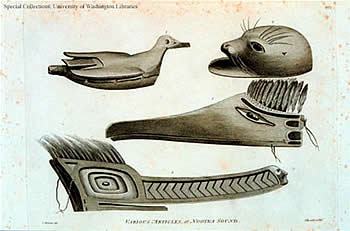
Within the cultures of Northwest Coast native peoples, trade with European and American ships was welcomed because it added wealth to economies that placed great emphasis upon the accumulation and disposal of wealth. Heads of households, and entire families, attained prestige through their ability to give away wealth, particularly in ceremonies known as potlatches. This drive to attain social status be disposing of property resulted in a pervasive cultural imperative to acquire possessions. When European and American traders arrived, eager themselves to acquire possessions in the form of sea otter pelts, materialistic natives jumped at the chance to acquire the manufactured goods, especially made of metal, that the traders offered in exchange. These goods, to which Indians mostly had not had access before, represented wealth in themselves, as in the cases of pieces of copper that could be made into jewelry or blankets that could be given or traded to other Indians. The goods also included tools which increased Indian households' ability to produce their own goods. Finally, the European economy also offered the opportunity of earning wealth through the sale of one's labor (and one's body, as rates of prostitution apparently increased among natives in response to non-native demand). In other words, natives engaged in the fur trade and related activities because they saw this form of exchange as a way to enrich themselves and their culture. It was not the case that, by incorporating European goods into their lives, natives became "less Indian" than before. Rather, they saw the maritime fur trade as a way to enrich their Indian ways of life. Northwest Coast natives were not simply passive victims of European and American capitalism. Already accustomed to trading before the arrival of non-natives, they saw in European and American maritime traders an opportunity to improve their lives.
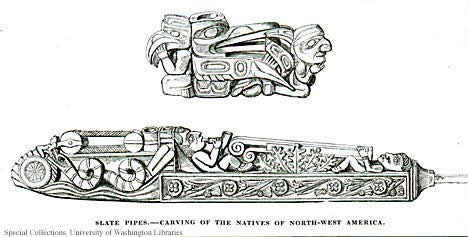
To a certain extent, furthermore, many Indians were able to shape the trade so that it took place largely on their terms. For example, at Nootka Sound the European traders initially tried to conduct business aboard their ships; over time, however, the natives moved the trade on shore, to their own turf, and drew it out over a few days in keeping with their customs. The Indians also became more sophisticated about the prices they charged, gradually demanding more and better goods in exchange for sea otter pelts. They learned to wait until two or more trading ships arrived, and got European traders to bid against each other, thus driving prices higher. Such tactics demonstrated a people adept at trading and capable of maximizing benefits from it. Some scholars have suggested further that Northwest Coast Indians gained through the trade because their acquisition of metal goods enriched their wood carving and other artwork.
Haida Slate Pipes, (above). These pipes are carved from argylite, a carbonaceous slate found in a single quarry on Queen Charlotte Island. Presently, only members of the Haida tribe are allowed to collect the mineral. From Edward Belcher, Narrative of a Voyage Round the World. London, 1843. Vol.1:102. (University of Washington Special Collections)
Although it is clear that Indians were not simply victimized by the maritime fur trade, it remains important to point out that it did not simply bring unalloyed benefits. For one thing, some native groups clearly profited more than others. Different groups of Indians tried to monopolize the trade with Europeans for themselves and drive other native competitors away. Most bands that did a lot of trading did not acquire the majority of pelts by themselves, but rather traded with or raided other Indian groups for them. Overall, the maritime fur trade likely increased divisions between different bands or groups of natives. Still another aspect of the trade was that it connected Indians to a global economy over which, ultimately, they had very little influence. Natives did not automatically become pawns of European capitalism, but they did grow more reliant on manufactured goods produced elsewhere (think for a second about the impact of acquiring and using firearms in the trade, and about how destabilizing that commodity could be among Indian groups), and they did change some of their subsistence patterns in order to meet the market demand for sea otter pelts. When those pelts became scarcer and the sea otter increasingly bordered on extinction in certain parts of the Northwest Coast (Nootka Sound had no more sea otter to hunt by 1795, ten years after the opening of the trade), additional adjustments were needed.
Right: "Pira y Sepulcros de la Familia del Cacique An-Kau en el Puerto de Mulgrave," 1792. These engravings after 1792 drawings show native family burial structures at Mulgrave. From Malaspina, Vaije Politico-Clientifico, 120. (University of Washington Special Collections)
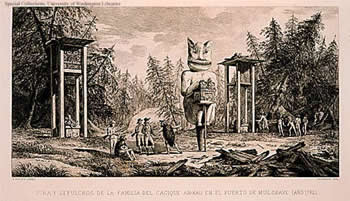 Scholars, especially those working on British Columbia, continue to debate over just how destructive the early fur trade was. In 1977, the historian Robin Fisher (in Contact and Conflict: Indian-European Relations in British Columbia, 1774-1890) suggested that natives and Europeans met as relative equals in the fur trade, and that the infusion of new wealth from the commerce produced a high point in Northwest Coast cultures. In other words, the trade was largely beneficial to both parties, prior to the establishment of British colonies in western Canada after 1846. Writing fifteen years after Fisher, James R. Gibson, Otter Skins, Boston Ships, and China Goods: The Maritime Fur Trade of the Northwest Coast, 1785-1841 (1992), strikes a more balanced tone, inventorying both advantages and disadvantages to Indians. More recently, finally, Cole Harris (in The Resettlement of British Columbia [1997] and elsewhere), taking issue especially with Fisher, has described a native world much more dislocated and disrupted because of the fur trade. Harris emphasizes the conflict between Europeans and Indians, the heightened inequities resulting from the new struggle for wealth, and the great devastation caused by diseases introduced in this era.
Scholars, especially those working on British Columbia, continue to debate over just how destructive the early fur trade was. In 1977, the historian Robin Fisher (in Contact and Conflict: Indian-European Relations in British Columbia, 1774-1890) suggested that natives and Europeans met as relative equals in the fur trade, and that the infusion of new wealth from the commerce produced a high point in Northwest Coast cultures. In other words, the trade was largely beneficial to both parties, prior to the establishment of British colonies in western Canada after 1846. Writing fifteen years after Fisher, James R. Gibson, Otter Skins, Boston Ships, and China Goods: The Maritime Fur Trade of the Northwest Coast, 1785-1841 (1992), strikes a more balanced tone, inventorying both advantages and disadvantages to Indians. More recently, finally, Cole Harris (in The Resettlement of British Columbia [1997] and elsewhere), taking issue especially with Fisher, has described a native world much more dislocated and disrupted because of the fur trade. Harris emphasizes the conflict between Europeans and Indians, the heightened inequities resulting from the new struggle for wealth, and the great devastation caused by diseases introduced in this era.
No doubt the most destructive effect of the maritime fur trade—recognized by both Fisher and Harris—was the heightened incidence of epidemic diseases among native peoples. Natives of the Americas had no immunity to the diseases that Europeans imported from the Old World, which meant that outbreaks of such illnesses as smallpox, measles, and malaria could be tremendously destructive;a rough estimate holds that Old World diseases depopulated native societies by about 90% within the first century of contact. Now, it is surely the case that these kinds of epidemic disease could and would have reached the Pacific Northwest without the advent of the maritime fur trade; after all, scholars estimate that the first epidemic of smallpox broke out around 1780-82, before the trade got started in a systematic way. But the regular contact that followed the opening of the trade—with more than two hundred vessels arriving between 1785 and 1804 to engage in trading—ensured that Northwest Coast Indians would be exposed repeatedly to multiple epidemic diseases against which they had little immunity or resistance. These diseases initiated the sustained demographic decline of native peoples in the Pacific Northwest between the 1770s and the beginning of the 20th century. The actual rates of depopulation are also matters of dispute among scholars; it has proven difficult to measure the effects of disease because the sources of information about them are so flawed and because such things as the possible rates of population recovery are not fully understood. Nonetheless, the anthropologist Robert Boyd suggests that between 1774 and 1874 the population of natives along the Northwest Coast—the area stretching roughly from the 60th parallel (southern Alaska) to the 42nd parallel (the Oregon-California border)—declined by 80%, from roughly 200,000 to about 40,000. The same scholar writes that the native population of the Columbia Plateau declined by 48% in the period 1805-1870. Disease accounted for the vast majority of these declines in population; commerce between natives and non-natives vastly increased the contacts between peoples that accelerated the spread of the disease. As with their relationship to global capitalism, Indians who encountered epidemic diseases found themselves caught inextricably in a web of invisible but nonetheless destructive forces, introduced from outside the region, over which they had little or no control.
* * * *
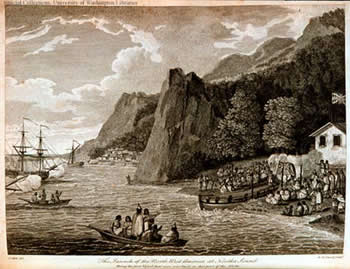 Launch of the North West America at Nootka Sound, 1788. The construction of the North West represented the permanence of the British presence at Nootka Sound. Note the Union Jack flying over the building at right. (From Meares, Voyages Made in the Years 1788 and 1789. London, 1790. Atlas, Plate 25. Sketch by C. Metz. (University of Washington Special Collections)
Launch of the North West America at Nootka Sound, 1788. The construction of the North West represented the permanence of the British presence at Nootka Sound. Note the Union Jack flying over the building at right. (From Meares, Voyages Made in the Years 1788 and 1789. London, 1790. Atlas, Plate 25. Sketch by C. Metz. (University of Washington Special Collections)
The maritime fur trade did not end abruptly, although the near-extinction of sea otters by the mid-1820s diminished it substantially. Rather, the maritime trade was absorbed by the land-based fur trade that reached the Pacific Northwest from eastern North America in the second decade of the 19th century. This trade—dominated through the mid-1840s by British companies—focused especially on such land mammals as beavers, but kept up some commerce in sea otter pelts, too. This second phase of the fur trade continued the transformations begun by the maritime trade—spreading epidemic diseases to Indians and transferring such items of European culture as blankets and rifles to native societies—but at the same time it ushered in new forms of utilizing the region. Land-based traders established fixed forts and posts, devised interior routes of travel, explored the inland region, and cultivated direct contacts with plateau and basin, as well as, coastal Indians. They also exploited resources besides fur, such as timber and fish and farmland and pasture, and thus demonstrated how the Pacific Northwest might be developed further by non-native colonizers. This second phase of the fur trade lasted roughly from 1810 until 1846.
| Course Home | Previous Lesson | Next Lesson |